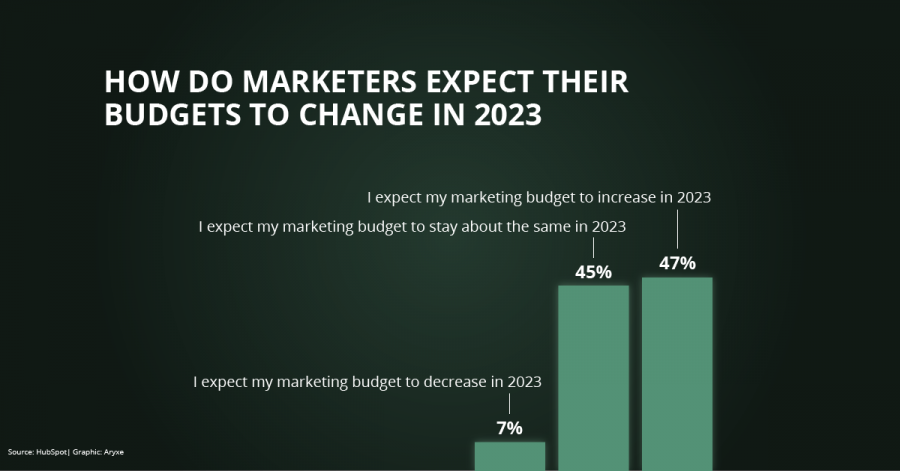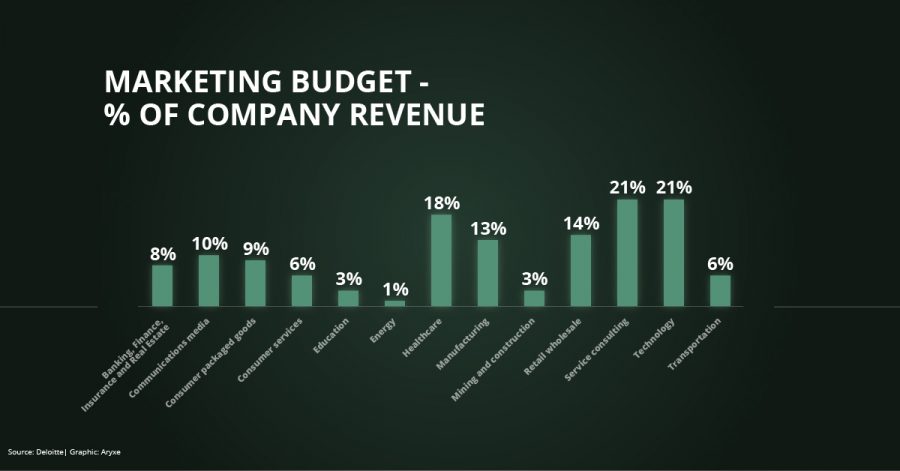Determining Your Marketing Budget for 2023
7 min read

7 min read

Effective marketing requires careful budgeting and resource allocation. As a marketer, you know that pitching new ideas to your team is an important part of the job, but you may also have encountered the common question, “how much of our marketing budget do we need to set aside for this plan?”
A clear marketing budget is essential for any business that wants to achieve growth and make smart, cost-effective decisions. In this article, we’ll examine the steps you can take to develop a successful marketing budget and compare your budget to those of your competitors. From setting clear goals and assessing your resources to staying up to date on industry trends, we’ll cover the key considerations for creating a budget that helps you drive results and achieve your business objectives.
A marketing budget is crucial for any business, regardless of size or industry. A marketing budget helps you allocate your resources effectively and make informed decisions about how to allocate your marketing efforts. Without a budget, you may end up overspending on marketing efforts that aren’t producing results or underinvesting in strategies that could drive significant growth.
A marketing budget also helps you set clear goals and track your progress toward achieving them. By setting budget limits, you can determine which marketing activities are most important to your business and allocate your resources accordingly. This can help you prioritize your marketing efforts and focus on the strategies that are most likely to drive results.
In addition to helping you allocate resources effectively and set clear goals, a marketing budget can also help you stay competitive in your industry. By understanding your competitors’ marketing budgets, you can gauge how much you need to spend to reach your target audience and drive results effectively.
Finally, a marketing budget can help you manage your finances effectively. By setting clear limits on your marketing spending, you can avoid overspending and ensure that your marketing efforts are aligned with your overall business goals. This can help you stay on track financially and make informed decisions about allocating resources.
Overall, a marketing budget is essential for any business that wants to allocate its resources and drive growth effectively. By setting clear goals, tracking your progress, and staying competitive, you can ensure that your marketing efforts are focused and effective.
Marketing is expected to make up around 13.6% of a company’s total budget in 2023, according to Deloitte’s Annual CMO Survey. This marks an increase of 3.9% from the previous two years. Despite the possibility of a recession, many marketers expect their annual budgets to increase in 2023.

In a survey of 1,000 marketers by HubSpot, 47% of respondents reported that their budget would increase, while 45% expected their budget to remain the same.

There is a shift in the prioritization of marketing channels. Traditional advertising is expected to make up a small portion of the marketing budget in 2023, decreasing by 0.7%. Instead, marketers plan to increase spending on social media and new media platforms. Facebook is expected to be the top recipient of marketing investment in 2023, with 25% of marketers planning to invest in the platform for the first time next year.
Video is also expected to be a significant investment in many marketers’ budgets. According to HubSpot, 91% of marketers plan to increase or maintain their investment in YouTube in the coming year, while 56% plan on increasing their TikTok investment – the highest increase of any social media app – and 34% plan to maintain their current TikTok budget. Influencer marketing is another tactic expected to see increased investment, with 89% of marketers planning to increase or maintain their investment in this area and an additional 17% planning to invest in it for the first time in 2023, according to our State of Marketing Report.
Over the past 12 years, businesses have allocated a more significant portion of their revenue to marketing, with the average at 13.8% in 2022. This represents an increase of over 5% since 2011. On average, B2B product industries allocate about 7.8% of their revenue to marketing, similar to B2C services (6.5%) and B2B services (5.9%). However, B2C product industries allocate the highest percentage at 15.1% of total revenue. Small businesses are also investing in marketing, with 52% of those surveyed in a study of 85 small business owners and marketers saying they spend between $5,000 and $15,000 per month on marketing efforts.

Marketing budget allocation decisions vary greatly depending on the industry. To better understand how marketing budgets are allocated in different sectors, let’s take a closer look.
Marketing budget allocation can vary significantly by industry. For example, the banking, finance, insurance, and real estate industry allocates an average of 8% of its revenue to marketing, while the consumer packaged goods industry allocates 9%. On the other hand, the healthcare industry allocates a larger percentage, with an average of 18% of its revenue going toward marketing efforts. The service consulting and technology industries also allocate a significant portion of their revenue to marketing, with 21% going towards these efforts. Other industries, such as education and energy, allocate a smaller percentage, with 3% and 1% of revenue going toward marketing, respectively. Therefore, businesses need to consider their industry’s specific needs and resources when determining their marketing budget allocation.

As a marketer, it can be helpful to use the above percentages as benchmarks, particularly for industries that allocate a smaller portion of their budget to marketing. If your industry tends to be cautious about investing in marketing initiatives, this can present an opportunity for your team to demonstrate the value and impact of marketing efforts. By effectively communicating the benefits of your top strategies and convincing decision-makers to allocate the necessary resources, you can set your company apart from competitors and serve as a model for how other teams should approach marketing.
Any reuse, transmission, republication, duplication, or distribution of this article and graphics, without the express written permission of Aryxe is not allowed. If you wish to reuse, transmit, republish, duplicate or distribute this article, cite passages, or use in full, including but not limited to proprietary text and graphics, please request written permission.